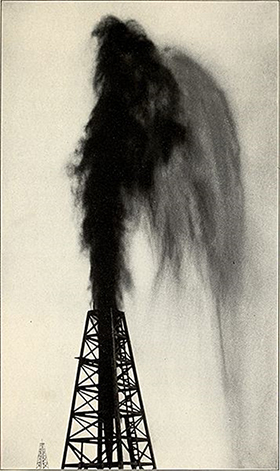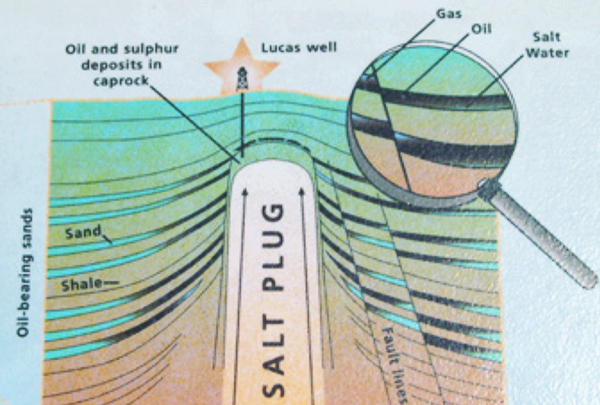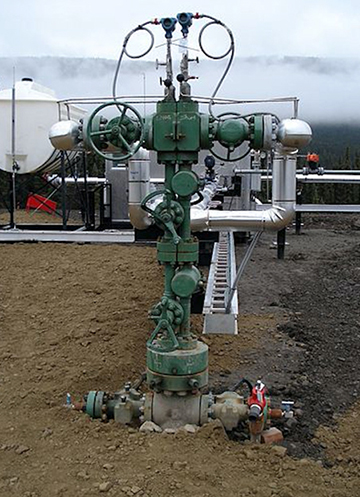
If you’re listening to this while driving, that’s due in large part to the oil boom—which happened over a hundred years ago.
At that time, Pennsylvania was the biggest oil producer, and automobiles were scarce. Then, Pattillo Higgins, a self-taught geologist from Texas, had an idea.
A low, flat hill outside his hometown was known for black tar that oozed from it. He thought the mound was a salt dome—a rising column of salt—and that oil must have migrated from deeper formations, up its sides.
Formally trained geologists chuckled, but Higgins raised enough money to start drilling. After a few dry holes, he was tapped out.
Undeterred, he brought in more investors, eventually shrinking his own share to zero—but he kept drilling.
In January 1901, his Spindletop well finally struck oil—and did it ever! The reservoir was under such pressure that it shot a geyser of oil 150 ft into the air.
For 9 days, workers struggled under a rain of a million barrels of oil, till they were finally able to cap it.
The first six Spindletop wells produced more oil than the rest of the world’s wells combined to that point in time. The Texas oil boom had begun. Supply soared and price plummeted.
Gasoline became cheap and readily available, helping launch the automobile age and personal mobility like the world had never known—that all of us in our cars still benefit from today.
Background
Synopsis: In the first weeks of 1901, an exploratory oil well based on a novel geological concept blew nearly a million barrels of oil more than 150 ft into the air over 9 days before drillers could bring it under control. It was the first oil well to target oil trapped on the flanks of a salt dome, and, from start to finish, it required engineering innovations that are still in use today. It also changed history, as abundant American oil fueled the country’s rapid transition to mobility.
- In the mid-1800’s the Industrial Revolution was in full swing, and new sources of cheaper and more convenient energy were in demand.
- Petroleum and its refined products, like gasoline, were just what the country needed for growth.
- In 1859, Colonel Edwin Drake drilled the first U.S. oil well in northwestern Pennsylvania.
- By the turn of the century, Pennsylvania was the top oil producer in the country, producing more than all the other states combined.
- In 1900, Texas produced just over 1 percent of the oil in the country, but that was about to change.
- For centuries, Native Americans had used the black tar that oozed out of the hilly ground near the southeastern Texas town of Beaumont for medicinal purposes.
- One of the big, broad hills in the flat coastal plain was called Big Hill, or Spindletop Dome. It was just 12–15 ft (4–5 m) high but more than 1 mile (1.6 km) in diameter.
- These hills were the surface expression of buried salt domes, with oil and tar seeps, smelly hydrogen-sulfate gas fumes, and sulfate deposits at their crests

Oil at Spindletop is trapped above a salt dome with a diameter of about 1 mile. The dome has steep sides and a flat top and is sealed by a caprock of limestone, anhydrite, and gypsum. Spindletop–Gladys City Boomtown Museum by Halfdan Carstens - Pattillo Higgins was a local mechanic and self-taught geologist who suspected the hills might be places where petroleum would accumulate.
- Higgins set up the Gladys City Oil Company in 1892 but ran out of money in a few years after drilling dry holes. He tried to find investors and finally got a response to a newspaper ad from a Croatian engineer, Anthony Lucas, who agreed with Higgins that salt domes should be good oil prospects.
- Salt is a weak, low-density rock that flows upward into swells and domes as it is progressively loaded with sediment. It bows layers of rock upward as it pushes its way toward the surface, kind of like toothpaste being squeezed through a tube.
- When you look at oily rainbow sheens in puddles, you can see that oil floats on water. Underground, oil migrates upward through water in the pores of rock until it hits an impermeable layer, such as the cap rock that forms over the top of salt domes. It can seep farther upward through any fractures in the caprock.
- After scouting possible locations, Lucas picked a spot on Spindletop Dome.
- Lucas drilled 575 ft before he ran out of money. He then sold the idea to two Pennsylvania oilmen, who cut Lucas’ share to one-eighth and cut Higgins completely out of the deal (Lucas and Higgins successfully sued and were recognized later).
- Drilling was difficult because hundreds of feet of loose sand in the hole kept caving in on the drill bit.
- One of Lucas’ drillers had a brilliant engineering idea that is still used today in wells drilled all over the world: instead of using water to flush the bits of rock chipped off by the drill bit to the surface, use mud.
- Water from mud invades pores in the sand, while mud solids build “mudcake” on the side of the hole, thereby stabilizing it. The rest of the mud sweeps the drill cuttings to the surface.
- By early January 1901, the well had reached 1,139 ft (347 m) when mud—followed by gas and then oil—suddenly began bubbling up from, then gushing out of, the hole.
- The oil was reservoired in the salt dome’s limestone caprock, as well as in spotty lens- shaped sands of Miocene and Oligocene age (12 to 28 million years old) on its flanks.
- The drill bit had hit a high-pressure sandstone oil reservoir that could not be controlled with the technology of the day. The Lucas Gusher blew the drilling tools out of the hole and then blew oil 150 ft high at a rate of more than 100,000 barrels per day, a rate higher than any other well had ever produced.
- A blowout occurs when pressurized reservoir fluids enter a wellbore and entrained gas expands more and more as it approaches the surface, causing a violent eruption of these flammable fluids at the surface.
- It took 9 days for drillers to figure out how to permanently control the gusher with a new invention called a “Christmas tree”—basically a series of valves, spools, and fittings on the surface that control the movement of fluids at the wellhead. Every deep oil and gas well completion today depends on this device.
- Today, drilling-mud engineers control the most dangerous wells in the world by using mud properties to counterbalance the pressure of hydrocarbons in the subsurface, preventing blowouts like the one that occurred at Spindletop.

- The Lucas Gusher was the start of the Texas oil boom, which propelled the United States into position as the world’s top oil producer.
- The first six wells at Spindletop produced more oil than all the rest of the wells in the world combined.
- Thousands of people hurried to the Beaumont area, more than tripling its population in three months from 9,000 to 30,000.
- By the end of 1902, more than 285 wells had been drilled and more than 500 companies were operating in the area.
- Oil companies like Gulf, Texaco, Amoco, and Humble (Exxon) got their start there, while East Coast giant Standard Oil was prevented from moving into the state for a while, allowing their competitors to grow.
- Additional oil discoveries on nearby salt domes followed, and thousands of oil fields were discovered in the Texas Gulf Coast.
- Production at Spindletop plateaued and started to decline in 1902. Deeper reservoirs were discovered in 1925, breathing new life into the field, but by 1936 it was shut in. It was mined for sulfur from the 1950’s to 1975.
- Energy and economic historian Daniel Yergin suggests that the discovery at Spindletop drove the United States into the oil age.
- Texas oil was abundant, and petroleum was an ideal fuel for mass consumption, which led to the shift from hard coal to liquid oil.
- Spindletop oil drove rapid expansion of the shipping and rail industries, also opening the doors for mass manufacture of trucks, automobiles, and airplanes, which all required a convenient mobile fuel source.
- Filling stations soon dotted the country, and Americans were mobile in a way that was unprecedented in history!
